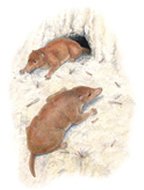Early mammal had newfangled fangs
A tiny mammal that lived in Colorado about 150 million years ago had hollow teeth that lacked enamel, a characteristic that didn’t reappear in mammals for another 100 million years.

Paleontologists report in the April 1 Science that they have unearthed the lower jaw, skull fragments, and about 40 percent of the rest of the skeleton of the chipmunk-size creature, a new species that its discoverers have dubbed Fruitafossor windscheffeli. The remains indicate the animal had a number of features previously unknown in mammals of its era, says Zhe-Xi Luo of the Carnegie Museum of Natural History in Pittsburgh.
First, each of Fruitafossor‘s molars was hollow and had a single, open-ended root, traits hinting that the teeth grew throughout the animal’s life. Mammals with similar teeth, the insect-eating ancestors of armadillos, didn’t appear until about 50 million years ago, says Luo.
Second, the size, shape, and arrangement of Fruitafossor‘s foot and leg bones indicate that the mammal spent a lot of time digging. Vertebrae joints that resist twisting also suggest a digging, or fossorial, lifestyle.
Taken together, the tooth structure and adaptations for digging suggest that Fruitafossor fed on termites or other insects that live in colonies, just as modern armadillos and anteaters do, says Luo. So far, no other mammals as old as Fruitafossor appear to have adopted such digging or eating habits, he notes.







